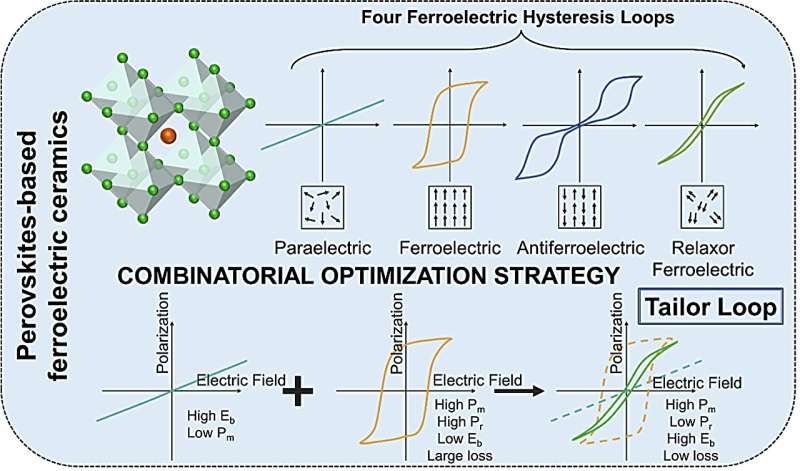This article has been reviewed according to Science X's editorial process and policies. Editors have highlighted the following attributes while ensuring the content's credibility:
fact-checked
proofread
New perspectives on perovskites-based ferroelectric ceramics for energy storage applications

With the escalating impacts of climate change and depletion of resources, dielectric capacitors are emerging as promising high-demanded candidates for high-performance energy storage devices. However, due to the shortcomings of various dielectric ceramics (e.g., paraelectrics, ferroelectrics, and antiferroelectrics), their low polarizability, low breakdown strength, and large hysteresis loss limit their standalone use in the advancing of energy storage ceramics. Therefore, synthesizing novel perovskite-based materials that exhibit high energy density, high energy efficiency, and low loss is crucial in achieving superior energy storage performance.
A team of material scientists led by Bingcheng Luo from the Department of Applied Physics at China Agricultural University recently outlined the state of perovskite-based ferroelectric ceramics for energy storage in the field. Perovskite-based dielectric capacitors have garnered attention for their superior stability, high energy density, high power density, high conversion efficiency, wide operating temperature range, environmental friendliness, and cost-effectiveness, distinguishing them from traditional electrochemical capacitors and batteries.
The team published their review in Journal of Advanced Ceramics.
"In this review, we outlined the recent development of perovskite-based ferroelectric energy storage ceramics from the perspective of combinatorial optimization for tailoring ferroelectric hysteresis loops and comprehensively discussed the properties arising from the different combinations of components.
"Also, we provided the future guidelines in this realm and therefore, the combinatorial optimization strategy in this review will open up a practical route towards the application of new high-performance ferroelectric energy storage devices," said Luo, senior author of the review paper, professor in the Department of Applied Physics at China Agricultural University, who received his Ph.D. in 2018 in Tsinghua University and then worked as Research Associate at University of Cambridge.
Dielectric materials can be categorized into four types depending on the hysteresis loops they exhibit paraelectric (PE), ferroelectric (FE), relaxor ferroelectric (RFE), and antiferroelectric (AFE), each of which has unique ferroelectric properties.
The research team outlines the progress made in the enhancement of the energy storage performance of perovskites-based lead-free ferroelectric ceramics.
"We classify the perovskites-based ferroelectric ceramics into seven types for tailoring ferroelectric hysteresis loops from the perspective of combinatorial optimization and comprehensively discuss the properties arising from the different combinations of components.
"The concept of combinatorial optimization is to maximize breakdown strength and maximum saturation polarization while slenderizing electric hysteresis loop, which bolsters the energy storage performance of perovskites-based ferroelectric ceramics," Luo said.
The seven types of combinatorial optimization of perovskites-based ferroelectric ceramics, namely, FE vs. PE combinations, FE vs. FE combinations, FE vs. AFE. combinations, AFE vs. PE combinations, RFE vs. PE combinations, RFE vs. FE combinations and RFE vs. AFE combinations were presented in this review.
Luo said, "As an example of combinatorial optimization strategies, ferroelectrics have higher maximum saturation polarization, and paraelectrics have higher breakdown strength, and the combination of the two creates an RFE that has the advantages of both materials and with a narrower hysteresis loop, the long-range ferroelectric order will become polar nanodomains, which will increase the energy storage density and efficiency of ceramics."
The concept of combinatorial optimization is to maximize the complementary advantages of each component. Generally, polarization and breakdown strength are mutually exclusive in dielectric materials. Blindly increasing the content of one component would not enable the combination to achieve high breakdown strength or polarization.
It is necessary to find the optimal balance between polarization and breakdown strength, which is also the balance of the content of each component in the system, and to tailor more optimized hysteresis loops to improve energy storage performance.
The team anticipates that their review of combinatorial optimization strategies will not only aid in the design of future high-performance passive devices but will also yield optimal understanding and guidance for the practical utilization of ferroelectric ceramics.
Additional study contributors include Suwei Dai, Xiaowen Wu from the School of Materials Science and Technology at China University of Geosciences Beijing; and Mengyang Li from the College of Science at China Agricultural University; and Yunyi Wu from the Research Center for Comprehensive Energy Technology at CTG Science and Technology Research Institute; and Xiang Li from Beihang University; and Yanan Hao from Beijing University of Posts and Telecommunications.
More information: Suwei Dai et al, Combinatorial optimization of perovskites-based ferroelectric ceramics for energy storage applications, Journal of Advanced Ceramics (2024). DOI: 10.26599/JAC.2024.9220904


















